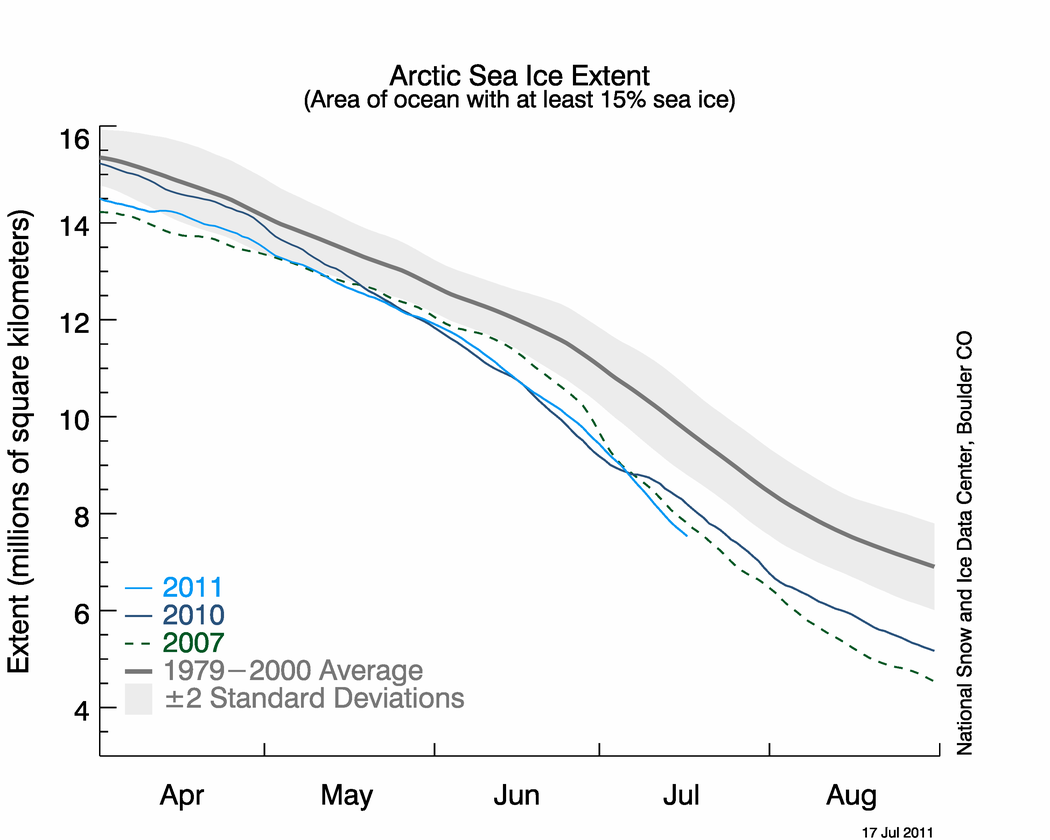International News
See other International News Articles
Title: Early sea ice melt onset, snow cover retreat presage rapid 2011 summer decline
Source:
nsidc
URL Source: http://nsidc.org/arcticseaicenews/2011/071811.html
Published: Jul 19, 2011
Author: nsidc
Post Date: 2011-07-19 23:40:56 by go65
Keywords: None
Views: 5385
Comments: 13
Arctic sea ice extent declined at a rapid pace through the first half of July, and is now tracking below the year 2007, which saw the record minimum September extent. The rapid decline in the past few weeks is related to persistent above-average temperatures and an early start to melt. Snow cover over Northern Eurasia was especially low in May and June, continuing the pattern seen in April. Overview of conditions As of July 17, 2011, Arctic sea ice extent was 7.56 million square kilometers (2.92 million square miles), 2.24 million square kilometers (865,000 square miles) below the 1979 to 2000 average. Sea ice is particularly low in the Barents, Kara, and Laptev Seas (the far northern Atlantic region), Hudson Bay and Baffin Bay. Figure 2. The graph above shows daily Arctic sea ice extent as of July 17, 2011, along with daily ice extents for previous low-ice-extent years. Light blue indicates 2011, dashed green shows 2007, dark blue shows 2010, and dark gray shows the 1979 to 2000 average. The gray area around the average line shows the two standard deviation range of the data. Sea Ice Index data. —Credit: National Snow and Ice Data Center Arctic sea ice extent declined rapidly through the first two weeks of July, at a rate averaging nearly 120,000 square kilometers (46,000 square miles) per day. Ice extent is now tracking below the year 2007, which saw the record minimum September extent. During the first half of July, a high-pressure cell persisted over the northern Beaufort Sea, as it did in June, and is linked to the above-average air temperatures over much of the Arctic Ocean. To date in July, air temperatures over the North Pole (at the 925 millibar level, or roughly 1,000 meters or 3,000 feet above the surface) were 6 to 8 degrees Celsius (11 to 14 degrees Fahrenheit) higher than normal, while temperatures along the coasts of the Laptev and East Siberian seas were 3 to 5 degrees Celsius (5 to 9 degrees Fahrenheit) higher than average. By contrast, temperatures through the first half of July over the Kara Sea have been 2 to 5 degrees Celsius (4 to 9 degrees Fahrenheit) lower than average. 
Post Comment Private Reply Ignore Thread
Top • Page Up • Full Thread • Page Down • Bottom/Latest
Begin Trace Mode for Comment # 2.
#2. To: go65 (#0)
The right wing conspiracists say climate change is a big hoax.
#6. To: NewsJunky (#2)
Have YOU driven a Prius Today?
Top • Page Up • Full Thread • Page Down • Bottom/Latestrapid 2011 summer decline
Replies to Comment # 2. The right wing conspiracists say climate change is a big hoax.

End Trace Mode for Comment # 2.
[Home] [Headlines] [Latest Articles] [Latest Comments] [Post] [Mail] [Sign-in] [Setup] [Help] [Register]
